
The Rapid Growth and Evolution of the Vintage and Retro Thrifted Clothing Market
The vintage and retro thrifted clothing market has experienced remarkable growth in recent years, capturing the interest of fashion-conscious individuals and attracting the attention of investors. Now, with companies like "Savers" going public, this once niche market has transformed into a thriving industry, catering to a diverse range of consumers. In this blog post, we will explore the factors contributing to the rapid growth of the vintage and retro thrifted clothing market and how companies like Savers have played a significant role in its evolution.
The market is experiencing rapid and transformative growth, driven by factors such as the rise of sustainable fashion, nostalgia, social media influence, expanding retailers, and changing consumer perceptions. The market's potential for further expansion becomes evident. With sustainability becoming increasingly important in the fashion industry, the vintage and retro thrifted clothing market is well-positioned to continue flourishing, offering consumers a sustainable and stylish way to express their individuality while preserving the planet's resources. So, whether you're an avid thrift shopper or new to the world of vintage fashion, now is the perfect time to explore the unique treasures waiting to be discovered in this dynamic and evolving market.

The increasing demand for sustainable fashion has been a major driver behind the growth of the vintage and retro thrifted clothing market. In an era where environmental consciousness is at its peak, consumers are more aware of the detrimental impact of fast fashion on the planet. Thrifted clothing offers a sustainable alternative by reducing the need for new garment production and extending the lifecycle of pre-existing items. This shift towards sustainable practices has propelled the vintage and retro thrifted clothing market into the mainstream. Companies in any part of fashion have embraced sustainability as a core value, providing a platform for consumers to participate in the circular economy and reduce their fashion footprint.

Vintage and retro clothing exudes a timeless charm and unique aesthetic that appeals to fashion enthusiasts. With a wide variety of styles and eras, these garments enable individuals to express their personal style and stand out from the crowd. Moreover, the nostalgia associated with vintage clothing evokes sentimental feelings and transports wearers back in time. This emotional connection further contributes to the growing interest in thrifted fashion. The vintage and retro clothing market offers a treasure trove of one-of-a-kind fashion finds, allowing individuals to curate their wardrobes with pieces that have a rich history, adding an element of individuality to their style.

Social Media Influence
Social media platforms have significantly promoted the vintage and retro thrifted clothing market. Influencers and fashion bloggers have embraced thrifted fashion, showcasing their unique finds and inspiring their followers to explore secondhand shopping. The power of social media in shaping trends and influencing consumer behavior cannot be overstated. Hashtags like #thriftedfashion and #vintagestyle have gained immense popularity, creating a community of fashion enthusiasts eager to share their thrifted treasures and exchange styling tips. This online visibility has propelled the market's growth and helped break down stigmas associated with wearing secondhand clothing. Social media platforms have made it easier than ever for seconhand fashion to reach a broader audience, resulting in increased demand and market expansion.
Platforms like Instagram and TikTok have become breeding grounds for thrifted fashion enthusiasts, influencers, and fashion bloggers who showcase their unique finds and inspire their followers to explore the world of secondhand shopping. Social media has propelled the vintage and retro thrifted clothing market into the mainstream. Also breaking down old stigmas and creating a space where secondhand fashion is celebrated.
Companies like Savers, Goodwill, and independent thrift stores have recognized the potential of the vintage and retro thrifted clothing market and have expanded their operations accordingly. Savers, in particular, has played a pivotal role in the market's growth. By establishing a vast network of thrift stores and investing in efficient inventory management systems, Savers has created a seamless shopping experience for customers. Their stores are well-organized, offering a wide selection of vintage and retro clothing that is easily accessible. Additionally, online platforms such as Depop, Poshmark, and FLEEK have emerged as popular marketplaces for selling and buying thrifted clothing, making vintage fashion more accessible than ever. These platforms have streamlined the process of finding and purchasing unique thrifted pieces, contributing to the market's rapid growth and allowing vintage fashion to find its way into the hands of more consumers.
Lastly, changing consumer perceptions have been instrumental in driving the vintage and retro thrifted clothing market's rapid growth. In the past, thrifted clothing was often associated with economic necessity or limited choices. However, as sustainability and individuality have gained prominence, consumer perceptions have shifted significantly. Thrifted clothing is now regarded as a fashion-forward choice, offering unique and affordable alternatives to mass-produced garments. The growing awareness of the negative environmental and social impacts of fast fashion has driven consumers to seek more sustainable and ethical options. Thrifted clothing provides an opportunity to express personal style while supporting a circular economy and reducing fashion waste. The changing attitudes towards secondhand shopping have contributed to the rapid growth of the vintage and retro thrifted clothing market.
In conclusion, the vintage and retro clothing market has experienced rapid growth due to various factors. The increasing demand for sustainable fashion, the timeless charm and individuality associated with vintage and retro clothing, the influence of social media, the expansion of retailers and online platforms, and changing consumer perceptions have all contributed to the market's evolution. As companies like Savers go public, the market's potential for further expansion and innovation becomes even more apparent. With sustainability becoming a paramount concern in the fashion industry, the vintage and retro secondhand clothing market is well-positioned to continue its upward trajectory, offering consumers a sustainable and stylish way to express their individuality while preserving the planet's resources.
You can shop for yourself or get any wholesale or bulk orders you need with TVF!
